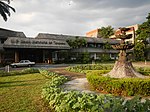New Era University (NEU) is a private educational institution in the Philippines, run by the Iglesia ni Cristo (INC). Although it is associated with the INC, it claims to be a non-sectarian university. Its main campus is at New Era, Quezon City, within the Central Office Complex of the INC. Aside from its flagship Quezon City campus, it has four other campuses around the Philippines, including one in San Fernando City (Pampanga), in Lipa City (Batangas), in General Santos City, and in Baras (Rizal).
Founded on 17 June 1975, it was known as the New Era Educational Institute, and was located in Echague, Quiapo, Manila, along Carlos Palanca St. It initially offered only secondary education (high school) but later expanded in 1977 to serve technical and vocational courses under its Center for Livelihood and Skills Training (CLST). It also offers graduate programs.
In 1981, it was renamed New Era College after the Ministry of Education, Culture and Sports (MECS) granted collegiate status, and later in June 1995, to its present name, New Era University, when the Commission on Higher Education (CHED) granted university status.
It is run by the INC for the educational needs of INC members, although it accepts enrollments from non-INC members as well. Formerly, under the university umbrella, it ran the College of Evangelical Ministry (now Iglesia Ni Cristo (Church of Christ) School for Ministers), where the INC trains male members to become ministers.
Other colleges include College of Engineering and Technology, College of Nursing, College of Business Administration, College of Arts and Sciences, College of Education, College of Music, College of Law, College of Computer Studies, College of Accountancy, School of Graduate Studies, and the then new College of Communication, College of Medicine, and Center for Medical and Health Allied Sciences. It offers new courses in the Philippines, including BS Real Estate Management and BS Criminology.
NEU is the legal owner of the Philippine Arena, which is the largest indoor arena in the world with a seating capacity of over 50,000.It annually hosts its graduation ceremonies at the Philippine Arena in Ciudad de Victoria, which is being developed because there is a proposal to move the main campus of NEU to this location.





